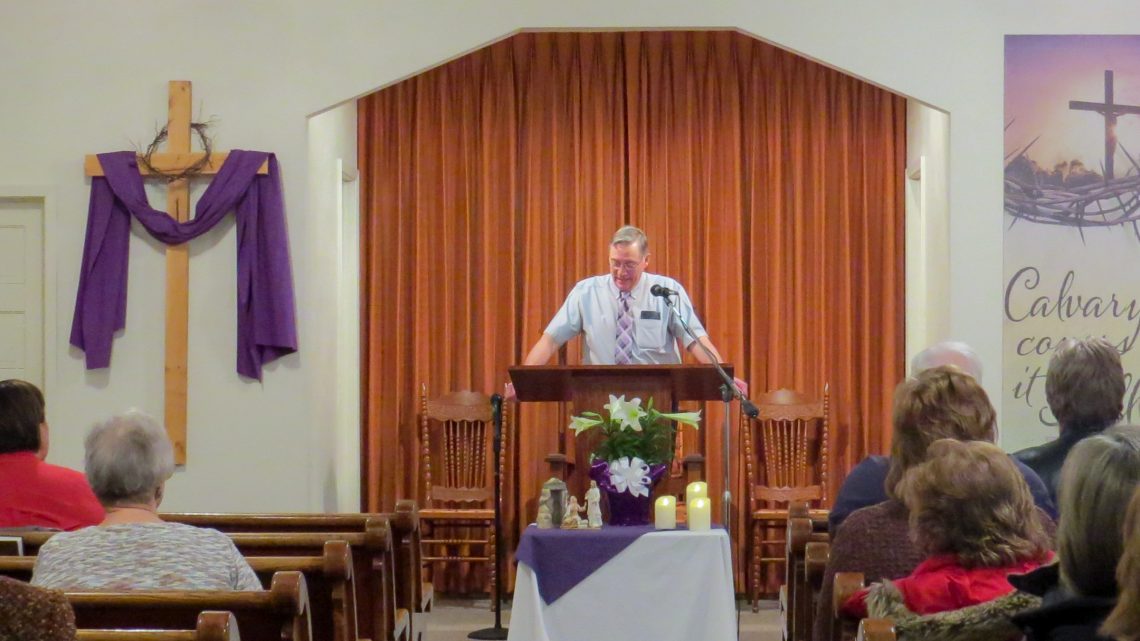One hour west of Des Moines, Iowa, a group of 12 people meet in the basement a small white building at the top of a hill to eat haystacks and homemade cupcakes. Only a couple of members are missing at this Sabbath afternoon rendezvous. They are busy planning to host the city of Guthrie Center twice over the next few days.
The Guthrie Center Seventh-day Adventist Church is one of 11 churches serving a population of just over 1,500. Like many small towns in rural America, local churches form a key element in the town’s social life. Soon after arriving, Pastor Steven Shafer joined the association of churches in the city. This has given the congregation a chance to form a more involved part of Guthrie Center.
This year, for Holy Week celebrations across town, the association arranged open-to-the-public prayer and breakfast times each morning at different churches, and Guthrie Center Adventist was on the list for that Tuesday.
“Everybody has to help, you can’t necessarily hide as in a big church,” says NAME, “and I appreciate that I have a job and that everyone helps.”
The underlying mission of the church has been its community approach. After the haystacks and cupcakes meal, the children stay below while the adults form a circle in the sanctuary to do some self-evaluation.
10 years ago, some members attended a town hall meeting hosted by the Iowa-Missouri Conference. There, elder Dean Coridan challenged attendees to take on “evange-living,” or evangelize not with words, but with actions.
The Guthrie Center church decided to take it to heart, and over the course of potlucks and church meetings formed an evange-living committee and appointed NAME to lead the charge.
They changed their approach from evangelistic meetings (that, according to long-time members, never had “phenomenal results”) to a “friendship ministry.”
The first activity they planned was an agape feast. It was so successful that the Guthrie Center church still holds them regularly, and there’s one scheduled for the next morning.
Another project has been closely working with the community food bank. Members who contributed the most pounds of food received prizes. “We hosted it once and did all the advertising for it and stocked it and the people running the food bank still comment on that first Pound Party,” remembers Glenda.
Other evangeliving projects include a Something Else Sabbath School, community baby showers for needy mothers, financial peace seminars, depression seminars, baking and giving every household in Guthrie Center a loaf of bread, a cooking school and:
“The water bottle thing—”
“The flower thing—”
“Slow down! We have to explain these.”
“Sitting here listing these things—we’re not bragging,” says NAME. “But we are only a group of 12 active members and we can do it.”
“I feel like this church always errs on the side of love,” says Emily Shafer, who is pregnant with a future member. “A visitor can’t come here and not have several people come up to them and say, ‘I’m so glad you’re here today!’”
There is, however, a slight problem over which the Guthrie Center church has no control over. In fact, many of the communities in the Mid-America Union territory have the problem, and it’s not a religious issue.
It’s a demographic issue.
Guthrie County, even as part of the Des Moines-West Des Moines Metropolitan Statistical Area, is the second oldest county in Iowa—not by date of establishment, but by age. Guthrie Center’s population has been on a downward trend, equal to population in the 1910s.
This city, along with many across rural America, is disappearing.
The church knows this challenge. “Our goal is that if there’s one more person in Guthrie County searching for the truth, we need to find that person,” says NAME. “Whether they end up coming to church here is not the goal. The goal is to get them ready for the second coming.”
“For this church, success may not mean a number of baptisms. It looks more like ‘we held a community event and 40 people came and it was amazing,’” says Emily.
“And that’s 40 more people who know who we are and what we are about,” finishes Glenda.
NAME nods. “If we believe that people will have to make a decision at some point, hopefully we will have been able to witness to people. I think, at the end, that is where we’ll see the results.”
NAME smiles. “If I had to pick a word to describe this church, it would be Love.” The group nods and acknowledges they were thinking the same thing.
The next day is business as usual. Healthy food is set on tables with simple decorations, ready to receive the community. In the end, 80 people, most of whom aren’t members of this church, attend the agape feast.
Agape feast, indeed.








